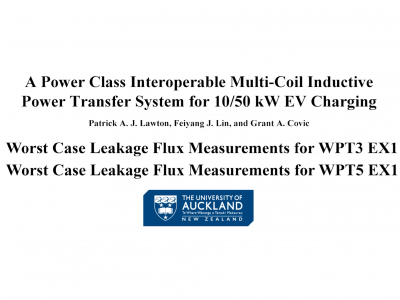Datasets
Standard Dataset
Magnetic Design Considerations for High-Power Wireless Charging Systems: 50 kW Experiment
- Citation Author(s):
- Submitted by:
- Patrick Lawton
- Last updated:
- Sun, 02/20/2022 - 14:37
- DOI:
- 10.21227/e2tf-5095
- License:
 463 Views
463 Views- Categories:
- Keywords:
Abstract
This paper proposes methods of predicting and preventing thermal failure within high-power ferrite structures of electric vehicle (EV) wireless charging inductive power transfer (IPT) by improving their ferrite layouts. A high-power IPT magnetic design suitable for wirelessly charging an EV at 50 kW using a heuristic approach is presented where the chosen design achieves reduced heating within the magnetic structure. Recommendations are made that both avoid ferrite fracturing due to magnetic hotspots and cause temperature differentials across ferrite tiles, and regarding airgap distribution between ferrite tiles to reduce loss-inducing circulating flux within the ferrite structure without reducing coupling. Power transfer was simulated in ANSYS and PLECS under misaligned conditions, and validated experimentally with 93.7% system efficiency. Thermal tests performed under rated volt-amps found the magnetics temperatures (after 30 minutes) could be reduced from 168 to 67 °C using an improved magnetic layout that reduced the thermal gradients within the ferrite tiles by 70%. Leakage fluxes were targeted and validated to be below 15 μT, 950 mm from the center of the vehicle under rated power and worst-case misaligned conditions.
A video demonstration of an experimental 50 kW inductive power transfer (IPT) fast-charging system for electric vehicles. The experiment was performed to validate research findings in the accompanying journal paper titled: "Magnetic Design Considerations for High-Power Wireless Charging Systems"
This experiment showcases the prototype system transferring rated power while the magnetics are under maximum airgap and pad misalignment condtions. The system operates with a dc-dc efficency of 93.7 % and maximum leakage flux is measured 950 mm from the VA center and observed to be below 15 μT.









Comments
nice